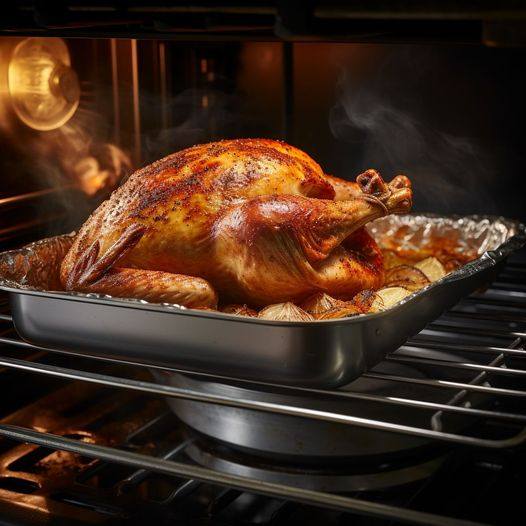ADVERTISEMENT
2. Use a Basting Technique
Basting the turkey periodically with melted butter, olive oil, or its own juices can help keep the bird moist while promoting a crispy, golden skin. This method works particularly well if you’re roasting at a higher temperature, as it creates the right balance between crispy skin and juicy meat.
3. Cover with Foil or a Roasting Lid
Another option is to cover your turkey loosely with aluminum foil for the first part of roasting. This traps moisture, helps cook the turkey evenly, and prevents the skin from burning. During the last 30-45 minutes of cooking, remove the foil to allow the skin to brown and crisp up.
4. Use Broth or Stock (Instead of Water)
If you’re concerned about keeping the turkey moist but don’t want to dilute the flavor of the drippings with plain water, consider adding broth or stock to the pan instead. Chicken, turkey, or vegetable broth will provide additional flavor to the pan drippings, which will help create a rich, savory gravy.
5. Brine the Turkey Before Roasting
Another method to keep your turkey moist without adding water to the pan is to brine the bird before roasting. A good brine—whether wet or dry—helps the turkey retain moisture throughout the cooking process. This allows the bird to stay juicy without relying on steam or added water during roasting.
When Should You Consider Adding Water to the Pan?
While it’s clear that adding water has its drawbacks, there are still some circumstances in which it might be helpful:
- Long Cooking Times: If you’re roasting a large bird (e.g., 20+ pounds), adding water to the pan can help maintain moisture during the long roasting process. This is especially useful if you are cooking the turkey at a lower temperature to ensure it’s cooked all the way through without drying out.
- Making Gravy: If you plan to make gravy directly from the pan drippings, a small amount of water (or broth) can help to loosen up the drippings, making it easier to create a smooth and flavorful sauce. However, be sure not to add too much liquid, as this can overwhelm the natural flavors of the turkey.
- If You Don’t Mind the Soggy Skin: If crispy skin isn’t your top priority, adding water can help with moisture retention. Just be prepared for a slightly different texture on the skin, which may be softer than you’d expect from a traditional roast.
Conclusion: Should You Add Water to the Turkey Pan?
In the end, whether you should add water to the turkey pan while roasting depends on what you’re looking to achieve. If you want a moist, juicy turkey with crispy skin and flavorful drippings, it’s best to skip the water and use methods like roasting on a rack, basting with butter, or covering the bird with foil to retain moisture.
However, if you’re concerned about keeping the turkey moist during long cooking times, or if you’re planning to make gravy from the pan drippings, adding a small amount of water or broth can be helpful—just be sure to keep the amount minimal to avoid diluting the flavor and ruining the texture of the skin.
By experimenting with these methods and techniques, you can determine what works best for your roasting style and ensure a perfectly cooked turkey every time.
ADVERTISEMENT
ADVERTISEMENT
